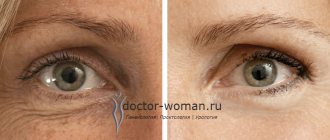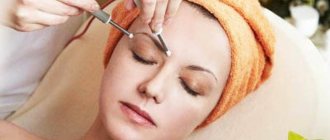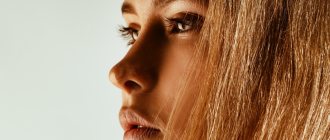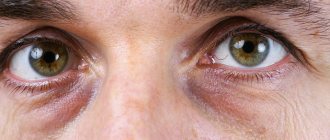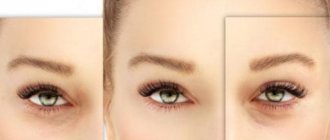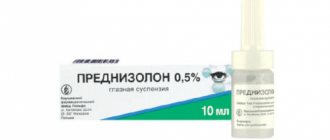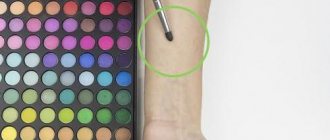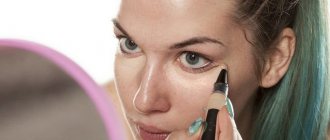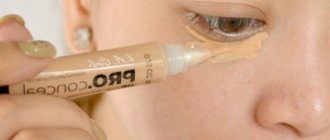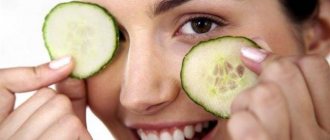Home › Questions and Answers › After biorevitalization, swelling under the eyes is the norm, if not, what to do?
To carry out biorevitalization, the Linline clinic uses a unique, expensive drug.
The main purpose of this procedure is facial skin rejuvenation. The medicine should only be administered by a specialist who has sufficient experience and approval to perform cosmetic surgery. The injection is administered extremely carefully so that there is no damage to the skin. That is why this procedure is recommended even for patients with highly sensitive skin.
Contraindications and side effects
“Beauty requires sacrifice” - this phrase is associated with a woman’s eternal desire for beauty at any cost, and is true when applied to rejuvenation using the biorevitalization method. In some cases, this miraculous procedure can be harmful to health, so it is not suitable for all women. Contraindications to its implementation are:
- Pregnancy.
- Breastfeeding period.
- Malignant tumors.
- Acute infectious diseases.
- The period of exacerbation of chronic diseases.
- Diabetes.
- Inflammatory processes on the skin (pustular, fungal, viral lesions, demodicosis).
- Chronic skin diseases (eczema, psoriasis, scleroderma).
- Systemic autoimmune diseases (rheumatoid arthritis, lupus erythematosus).
- All types of allergies.
- The presence of keloid scars on the skin.
Hyaluronic acid is a powerful biostimulant and can “spur” the growth of tumors, the development of infections, and cause exacerbation of chronic diseases and allergies.
However, the most harmless side effects of the procedure performed on healthy patients are quite common and include:
- swelling under the eyes;
- bruises;
- formation of microhematomas in injection areas;
- formation of persistent papules (areas of skin compaction).
Any undesirable consequences of the facial biorevitalization procedure do not arise out of nowhere, but have their own reasons.
Bruises after biorevitalization
The causes of bruising in the skin are:
- low qualification of the specialist, damage to blood vessels due to too deep injection of filler;
- the patient has vascular diseases;
- decreased blood clotting (often due to taking aspirin or other anti-inflammatory drugs);
- high blood pressure;
- too thin skin, superficial arrangement of blood vessels;
- improper facial care after the procedure.
If the patient is healthy and the specialist has sufficient qualifications and experience, then in principle there should be no bruises.
Swelling after biorevitalization
The causes of persistent swelling on the face after the injection of hyaluronic acid may be:
- intolerance to hyaluronic acid or other components of the administered cocktail;
- low-quality or uncertified filler mixtures;
- structural feature of the skin and subcutaneous tissue.
Moderate swelling under the eyes after the procedure or a “fat” face is a normal phenomenon that goes away within 1-3 days.
Rating of popular funds
For those who are not ready to correct the area around the eyes with fillers, it is better to start with the use of surface products with the effect of filling wrinkles and tightening tissue. A variant of this group of drugs is Skipofit. The cream acts superficially, but gradually eliminates the severity of the problem.
The result of using such means is noticeable, but far from ideal. To quickly obtain the expected effect, you will have to use the injection of the gel.
To choose the appropriate option, it is recommended to pay attention to the rating of popular tools:
Sculptra not only corrects defects, but also effectively triggers its own neocollagenesis and helps restore lost volume.
Radiesse is ideal for obtaining a rejuvenating effect.
Juvederm is a biorevitalizant with easy administration, long-lasting action, and a wide range of drugs.
The styling is characterized by maximum naturalness of the result.
Restylane and Perlane are drugs from a single line, differing in density. The products are basic for allergy sufferers and carry a minimal risk of side effects.
Teosal is ideal for correcting delicate eyelid skin and has a light consistency.
Belotero gives a powerful biorevitalizing effect and the results last a long time.
Amaline is a domestic biocompatible product with an attractive price.
Princess gives a rejuvenating effect, goes on smoothly, and lasts a long time.
Ellans has a composition that is mixed in biocompatibility and has the longest lasting effect.
A cosmetologist will help you make the right choice. The doctor is guided not only by the annotation of the drug, but also by the individual characteristics of the patient, the state of the problem, and is guided by personal experience in using the drug.
Methods for eliminating bruises and swelling
Bruises
Bruises on the face resolve on their own within 10-14 days.
But for a woman this is a long “probationary period”. In order to quickly remove bruises after the rejuvenation procedure, you should use ointments that accelerate their resorption. Troxevasin, Traumeel, heparin, hepatothrombin ointments have a good effect; they thin the blood, thereby improving its microcirculation, increasing metabolic processes and accelerating resorption.
These ointments should be used from the 2nd day after the procedure, applied with careful light movements, without massaging the face, 2-3 times a day. A proven folk remedy, badyaga, is also suitable; the powder should be mixed with vegetable oil and compresses should be made at night. It is better and more convenient to use a ready-made pharmaceutical cream or badyaga gel. This treatment will speed up the resorption of hematomas by 2 times.
Edema
Typically, swelling is localized in the eyelids, lips and nasolabial folds. If they are not very pronounced, you can try to remove them at home by applying cold lotions from a decoction of chamomile or oregano. It is good to take diuretics once a day in the morning for 2 days. You need to sleep on your back, propping up several pillows so that your head is as high as possible.
If within 3 days the swelling does not decrease, or tends to increase and thicken, you need to contact the specialist who did the injections.
This may be a reaction to hyaluronic acid or its concentration in the tissues is too high. In these cases, the enzyme hyaluronidase, which neutralizes it, is introduced. It will quickly eliminate swelling and hardening areas, but you will have to choose a different method for skin rejuvenation.
On average, recovery after this rejuvenation procedure can take from 3 to 10 days: swelling in the eyelids and cheeks disappears within 2-3 days, on the lips - up to 7-8 days, hematomas - up to 10-12 days.
And if you treat these consequences, healing will occur faster.
How to remove papules after biorevitalization yourself?
Is it possible to somehow speed up the recovery process and remove papules faster after biorevitalization? Of course, this is facilitated by compliance with the basic rules and conditions that the cosmetologist explains. It is also worth considering that following the recommendations will most likely avoid complications and minimize risks.
Let's start with how to remove papules after biorevitalization using procedures. The following types of therapy are used for this:
- Lymphatic drainage;
- Resorption therapy;
- Anti-inflammatory therapy.
Various healing creams, which should be prescribed by a cosmetologist, also help. Without them, papules after biorevitalization will resolve more slowly, because how long this will take depends on the body itself.
Against the background of procedures that will help restore the skin and eliminate marks after injections, it is important to follow the basic rules. This will both reduce papules after biorevitalization and avoid possible complications
Among the recommendations that must be followed after the procedure, it is worth highlighting the following rules:
- Do not scratch or rub your face while marks from the procedure remain on the skin;
- You cannot sleep with your face in the pillow and cover your head with a blanket;
- It is forbidden to massage or knead the puncture sites;
- It is strictly forbidden to use masks, scrubs and other similar procedures during the recovery period;
- It is prohibited to use cosmetics to hide spots on the skin;
- For the first two days, it is forbidden to use any means for washing (it is also better to refrain from washing at all);
- For the first week, it is necessary to limit exposure to the sun, wind, frost and any bad weather. If necessary, you need to protect your skin as much as possible (with hats, visors, etc.);
- It is forbidden to go to the bathhouse, swimming pool, gym and other similar places for up to two weeks;
- Refrain from drinking alcohol and smoking for up to 7 days.
Finally, it is worth noting that in the absence of significant complications in the first 1-2 days, for example, allergies or redness, the papules will heal very quickly. After just 3 days, you can return to your normal life, go to work and appear in public without discomfort, and after a couple of weeks you can completely return to your normal activities.
Incredible! Find out who is the most beautiful woman on the planet in 2020!
L oading. . .
Prevention methods
To prevent or reduce the undesirable consequences of filler injections, follow these measures:
- Before the procedure:
- 1 week before, stop taking medications that reduce blood clotting (aspirin, paracetamol and analogues);
- 3 days in advance, eliminate alcohol, salty foods, canned food, and citrus fruits;
- 2-3 days in advance, exclude physical activity, training, visiting the sauna, swimming pool, solarium.
- After the procedure:
- Do not perform cosmetic procedures (masks, massages, peelings) for a week;
- For a week, exclude physical activity, visiting the gym, swimming pool, sauna, solarium;
- Do not consume alcohol, salty or spicy foods for 3 days.
Question answer
- How many procedures need to be done?
It depends on the problem being solved and the type of procedure chosen. In some cases, 3 sessions are enough, and for others a course of 10 procedures will be recommended if the skin condition is very advanced.
- Biorevitalization and mesotherapy: what is the difference?
These two rejuvenation techniques cannot be differentiated. Biorevitalization is a type of mesotherapy. The latter uses a wide range of meso-cocktails, which do not necessarily include hyaluronic acid. Biorevitalization does not exist without hyaluronate.
- What is better: biorevitalization or mesotherapy?
In light of the previous answer to the question, mesotherapy has a wider list of indications. For each cosmetic problem within the framework of mesotherapy, you can choose your own meso cocktail. If your main goal is rejuvenation, it is better to sign up for biorevitalization.
Find out about the main differences between these procedures and more in the next article.
- What is better: biorevitalization or bioreparation?
In the classical sense of this term, biorevitalization is the introduction of pure hyaluronic acid under the skin without auxiliary components. Bioreparation enriches cells with all sorts of additives - methionine, cysteine, glutathione, etc. In the first case, the list of indications is limited, in the second it is more expanded. Biorevitalization gives a guaranteed lasting effect for 3 months, bioreparation - for all 6. Which one is better is up to you to decide.
- What is better: biorevitalization or plasma lifting?
In terms of effectiveness, it is believed that plasma lifting is better. The results are brighter and more noticeable, lasting and long-lasting, while the risk of complications and side effects is minimal, unlike biorevitalization. However, plasma lifting requires a lot of preparation and a huge number of tests. And not every patient can withstand the procedure of collecting her own blood.
- How often should I do it?
The question of how often biorevitalization can be done is decided on an individual basis. Usually a course of 3-8 sessions is prescribed. There should be a break of about two weeks between them. After this, you can repeat the procedure 1-2 times a year.
- When is the result visible?
The result can be noticeable within a week, but sometimes you have to wait longer - until at least 2-3 sessions have been completed. It all depends on the drug administered.
- Is it possible to do biorevitalization after Botox?
It is possible, but only after 3-4 months.
- At what age can you do it?
It is believed that the production of the body’s own hyaluronic acid stops at the age of 28 (approximate age). So after this date you can already sign up for the procedure.
- Is it possible to do peeling after biorevitalization?
Any peeling after biorevitalization can be done only after 3-4 weeks, when the skin has completely recovered from the stress it has suffered.
- Biorevitalization or fillers?
It depends on what effect you expect from the procedure. Fillers smooth out wrinkles and add volume to certain parts of the face. Hyaluronate has a wider spectrum of action, but if you increase the volume of your lips, it will not be as effective as Botox.
Facial biorevitalization is one of the advanced and most popular skin rejuvenation procedures. A wide range of drugs used in this procedure allows you to choose the best option to eliminate almost any age-related changes.
https://youtube.com/watch?v=tm8k3mXep5Q
Alginate masks at home
An alginate face mask at home today is no less (and sometimes even more) popular than its salon counterpart - thanks to the availability and widespread availability of the main raw material for it - sodium alginate. You can purchase it at an inexpensive price in almost any modern cosmetic store and the corresponding departments of large pharmacies.
There you can also choose some additional products for masks of this kind - it is important to remember that to combat any specific disorder you need to use “amplifier” components, leaving alginate to act as a base. Reviews from those who have used exclusively “clean” masks from this product are often full of disappointment
It must be remembered that alginate masks are not a panacea, but they have a beneficial effect “a little bit everywhere,” and, more importantly, they enhance the effect of additional components in their composition.
Factory made masks
Manufacturers sense the moods of their consumers quite subtly, so they offer a fairly wide range of powders for preparing complex alginate masks:
- Collagen - contain “fragments” of collagen molecules and some other substances that promote the regeneration of connective tissue fibers of the skin. They are used for sagging skin, as well as for rejuvenating the oval of the face.
- Fortified - alginates in combination with ascorbic acid and other vitamins. Used against the effects of photoaging, to reduce pigmentation, and as antioxidant masks.
- Chitosan - are prescribed for dry or desiccated skin (including due to improper cosmetic procedures), as they have an increased moisturizing effect.
- Plant masks are the largest and most diverse group of alginate masks, including plant extracts. Depending on the properties of the extracts themselves, they have a wide variety of effects and are used for a wide range of skin problems.
The choice of a particular mask depends on the expected effect and type of skin problems.
Homemade masks
If you want to make a mask yourself, it is enough to purchase simple sodium alginate and some other components of masks for home preparation. The most popular and common recipes for masks for home use, which are the most frequently discussed and reviewed, are presented below.
You need to mix 2 grams of sodium alginate with 2 tablespoons of water at room temperature, preferably mineral. At the same time, 10 grams of white clay or cosmetic diatomite is diluted in a separate bowl. The contents of both containers are infused for 5 hours, after which they are mixed and 1 ampoule (5 ml) of a 10% calcium chloride solution is added to them. The resulting mixture is basic - by adding various substances to it, you can create masks with specified properties. You can also use it in its pure form to prevent various disorders, especially for oily skin.
You can also take the base composition and add shiitake mushrooms mashed in a small amount of water (2-3 grams of dry powder). This remedy of oriental medicine is recognized in the world as one of the best stimulators of cellular restoration and rejuvenation. Therefore, its presence in an alginate mask will help smooth out wrinkles, disappear age spots and other signs of facial aging.
You can also use another mask at home, prepared according to a different principle than the base solution. To do this, you need to take 2-3 grams of sodium alginate powder, 10 grams of white clay, 1 teaspoon of kelp powder (brown seaweed) and 50 ml of purified water. This mask, applied twice a week, will help restore the firmness and elasticity of the facial skin.
These recipes have been tested by thousands of people around the world and therefore have proven their reliability and effectiveness.
Preparing to apply the mask
- you need to check for the presence or absence of allergies - apply a little mixture to the front surface of the wrist and wait a couple of hours; if irritation or redness or itching appears - use of the mask is prohibited;
- the effectiveness of this product increases many times over if the skin is steamed beforehand;
- It is also advisable to clean the surface of the skin and pores - to do this, just wash the skin with any scrub;
- After removing the film (alginate mask after it dries), it is advisable to apply a non-greasy cream to the surface of the skin.
If you follow all these recommendations and choose the right components of the mask, a stunning effect is guaranteed.
